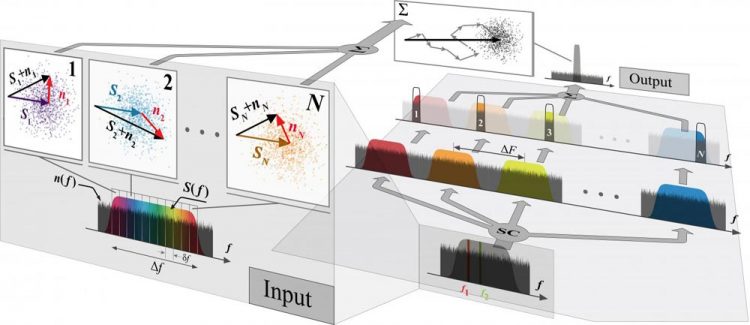Noise can't hide weak signals from this new receiver

Schematic of single-event noise discrimination using the spectral cloning receiver. Credit: Photonics Systems Group at UC San Diego
The study, published in the Dec. 11 issue of Science, lays the groundwork for a new class of highly sensitive communication receivers and scientific instruments that can extract faint, non-repetitive signals from noise. The advance has applications in secure communication, electronic warfare, signal intelligence, remote sensing, astronomy and spectroscopy.
The research is motivated by a long-standing need to capture random, singly-occurring phenomena in nature and in communications. An example of these includes the spontaneous decay of a molecule, an event that emits a single noisy signal and therefore eludes detection by conventional methods.
Because a standard detector must repeat measurements of the event multiple times to confirm its existence, it prevents, in principle, the capture of a random, non-repetitive event. Another limitation is that the capture of a fast event requires an equally fast detector.
To overcome the limitations of conventional detection methods, UC San Diego researchers developed a spectral-cloning receiver that works by replicating the received noisy signal to generate multiple spectral (colored) copies, and then combines these copies to reveal the existence of the signal within the noise.
“With the new receiver, it is now possible, at least in principle, to capture an ephemeral, non-repeating signal and observe fast, sparsely occurring natural or artificial phenomena–that would otherwise be invisible to us–over a long period of time, using a slow detector,” said Stojan Radic, an electrical engineering professor in the Jacobs School of Engineering at UC San Diego and senior author of the study
In the Science paper, researchers report that the spectral-cloning receiver they developed “can potentially intercept communication signals that are presently considered secure.” These signals are based on singly-occurring bursts, which disappear before another measurement can be taken to separate noise.
Radic also noted that the receiver could enable communication at a longer distance and with higher security. For example, it would be possible to bury the communication channel in noise and still detect it using the new receiver, while being well below the sensitivity threshold of conventional detectors.
The new receiver physics can be compared to a “temporal microscope”: it can see a very fast, faint signal while observing over a much larger time interval. However, while an ordinary microscope cannot eliminate surrounding image noise, the new receiver can differentiate between the noise and the signal fields.
In their experiments, the team used a new class of tunable optical frequency combs–developed in Radic's Photonics Systems Group at UC San Diego–to simultaneously create multiple spectral clones of a fast pulse. Researchers combined these clones to extract the signal from the noise and were able to reconstruct its timing and shape. They found that a higher spectral clone count resulted in higher sensitivity of signal detection by the spectral-cloning receiver.
“We were surprised that this concept could be scaled up to a high number of spectral copies. We are now able to construct a receiver that operates on hundreds of freely tunable copies,” said Radic. “This work is a result of long-standing research on tunable frequency combs at UC San Diego. The new class of combs are nearly noise-free and, in contrast to conventional frequency combs, can be freely tuned over a wide spectral range.”
###
Full paper: “Subnoise detection of a fast random event,” by V. Ataie, D. Esman, B. P.-P. Kuo, N. Alic, and S. Radic. The paper is published in the Dec. 11, 2015 issue of Science.
The work is funded in part by the Defense Advanced Research Projects Agency (DARPA). The University of California has filed a patent on the method and applications of random signal detection and coherent analysis.
Media Contact
All latest news from the category: Communications Media
Engineering and research-driven innovations in the field of communications are addressed here, in addition to business developments in the field of media-wide communications.
innovations-report offers informative reports and articles related to interactive media, media management, digital television, E-business, online advertising and information and communications technologies.
Newest articles

Redefining Cancer Science: Rodents, Humans, and the PD-1 Puzzle
Results of a comprehensive analysis refute assumptions that a key immune checkpoint receptor functions the same in rodents and humans The Discovery of PD-1: A Milestone in Cancer Treatment Since…

Heart Surgery Risks: Low BP Linked to Postoperative Kidney Injury
First large cohort study at the Heart and Diabetes Center NRW awarded – Hilke Jung presents research project at the FoRUM conference of the Ruhr University Bochum A working group…

Microbial Secrets: Boost Plant Growth with the Power of Soil Bacteria
To stay healthy, plants balance the energy they put into growing with the amount they use to defend against harmful bacteria. The mechanisms behind this equilibrium have largely remained mysterious….



